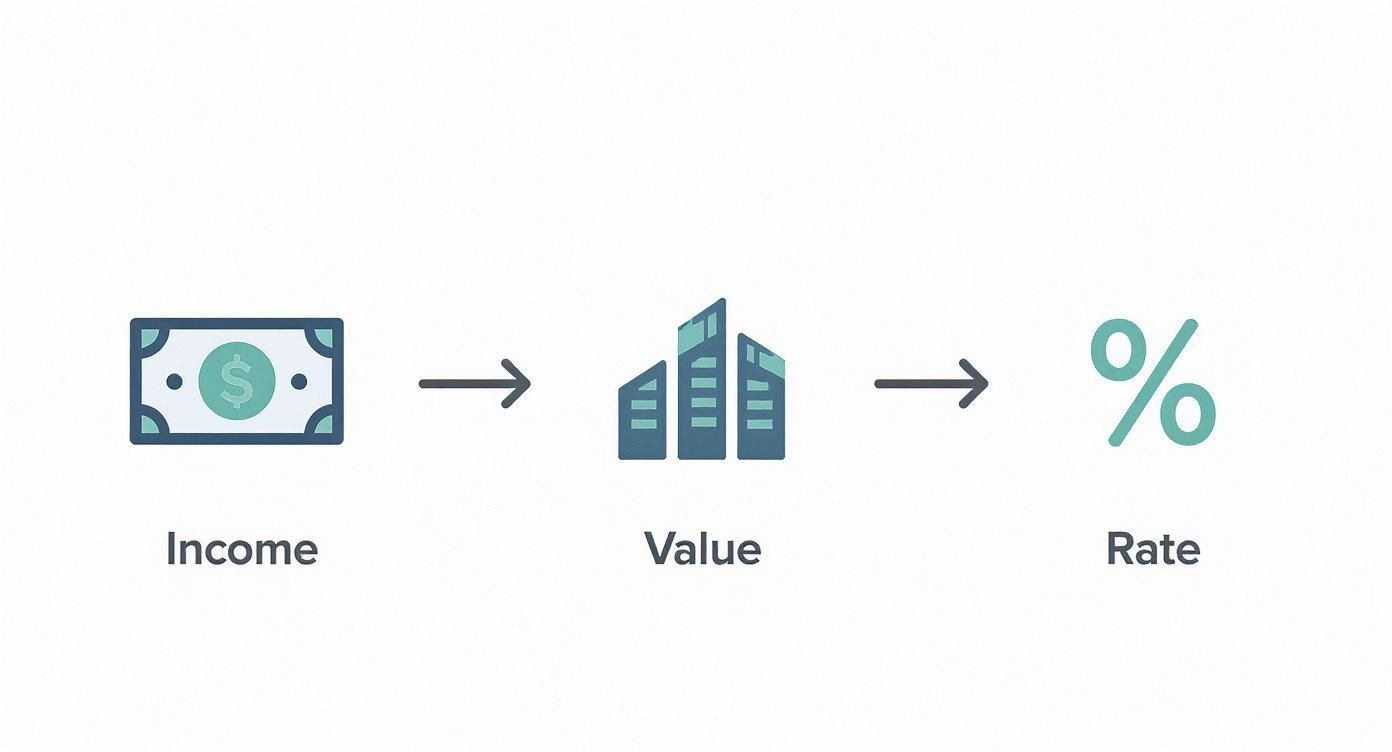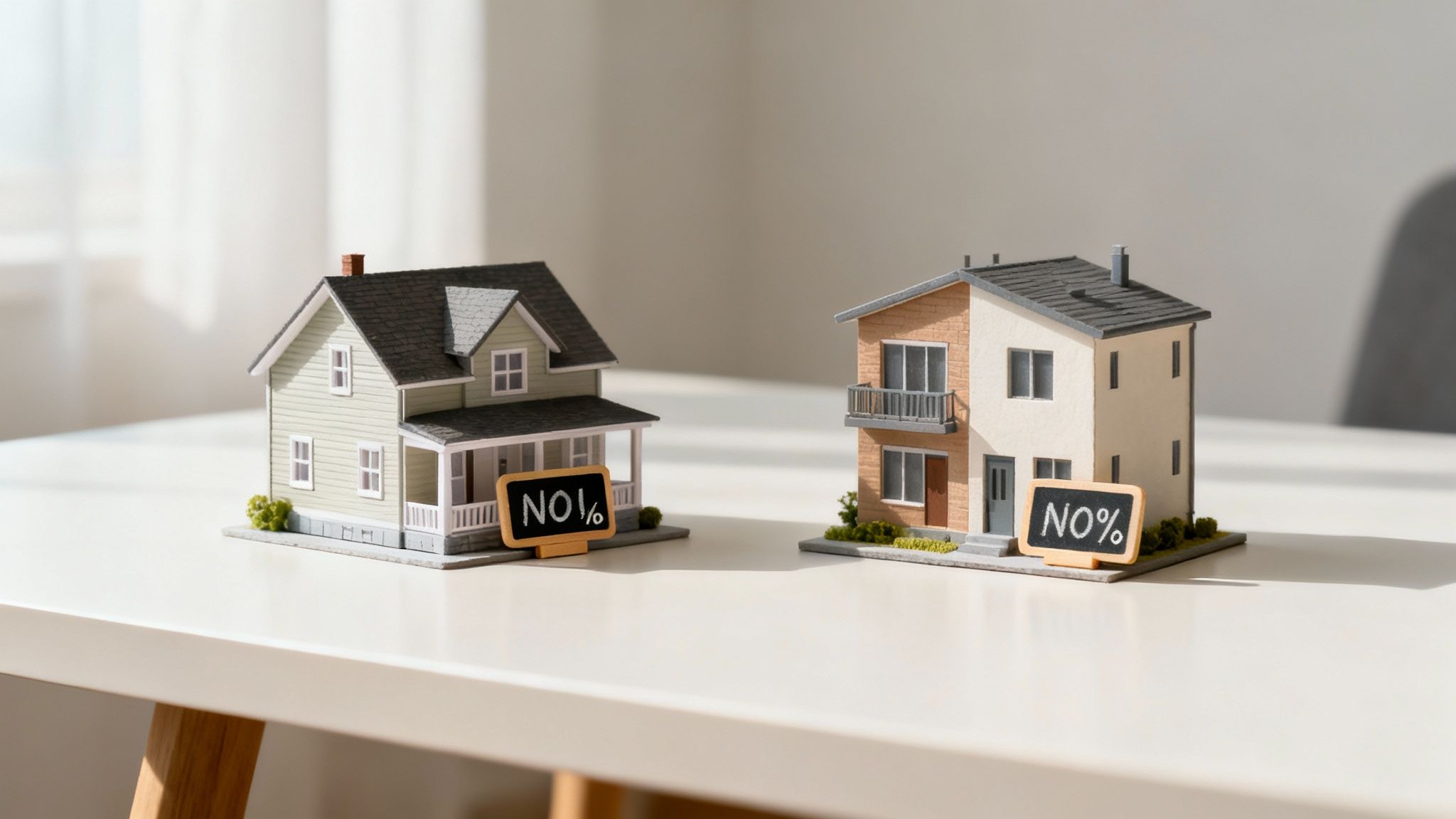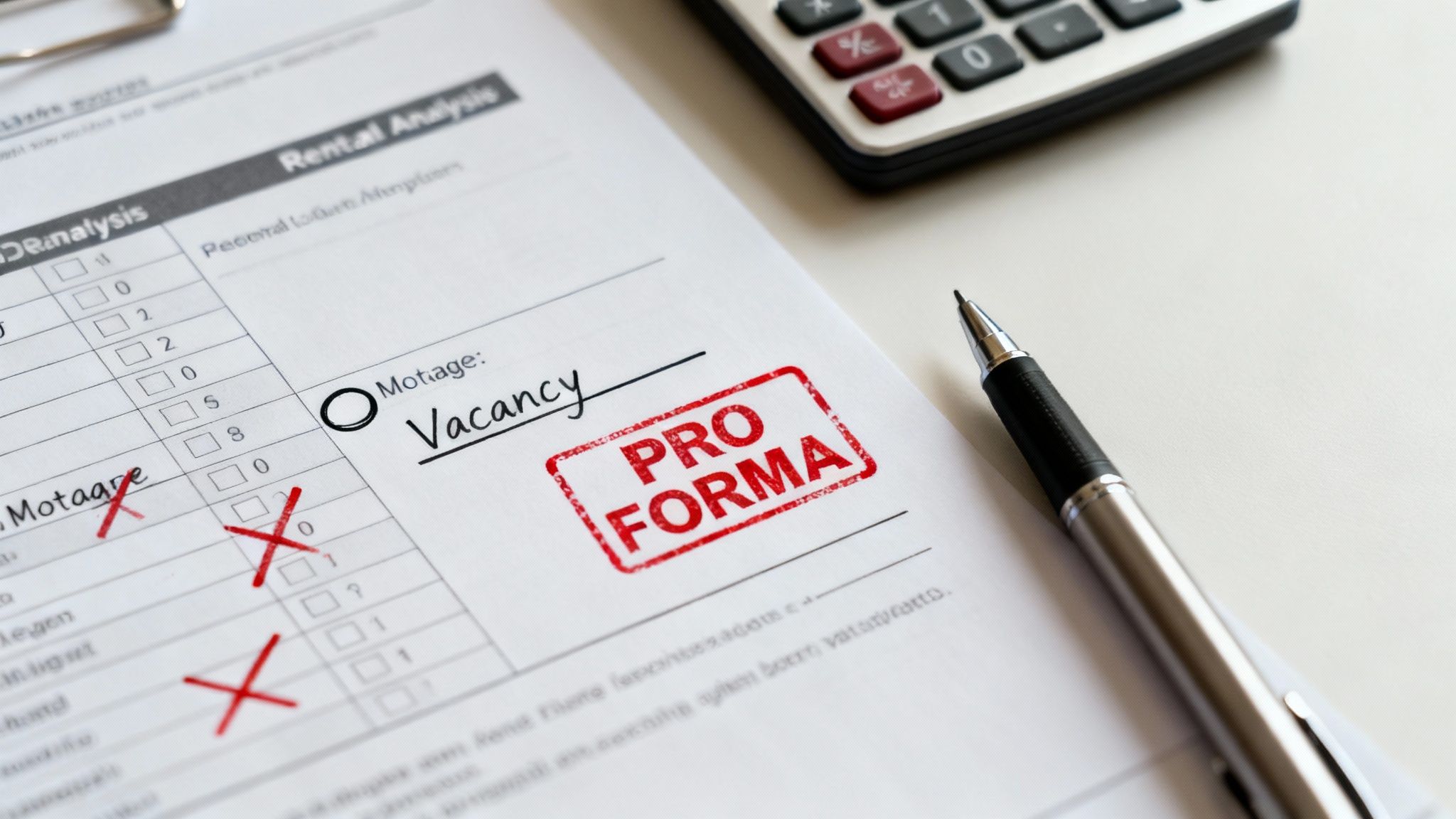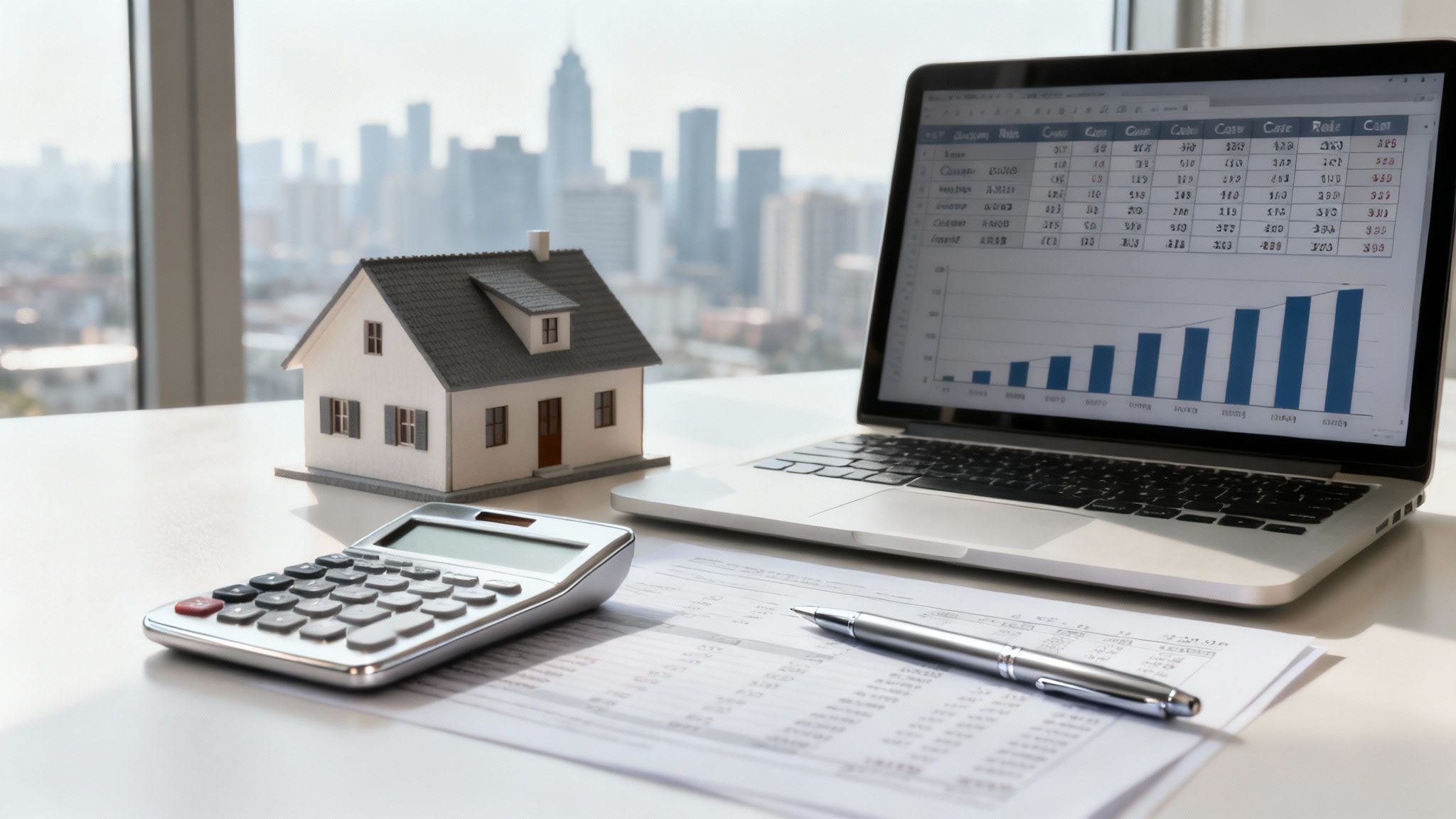To calculate the cap rate for an investment property, you simply divide its Net Operating Income (NOI) by its current market value. Think of it as a quick, back-of-the-napkin calculation that shows you the potential rate of return before financing, offering a clean snapshot of a property’s profitability.
Why Cap Rate Is Your Go-To Metric for Comparing Properties
Before you get lost in complex spreadsheets, it’s important to understand what the capitalization rate—or cap rate—really tells you. It's like a quick financial health check for an investment property. It reveals the potential profitability based purely on the property's income and its market price, completely separate from your mortgage or loan terms.
This metric is essential because it lets you compare the earning potential of completely different properties on an apples-to-apples basis. A cap rate shows you the raw, unleveraged rate of return you might expect. For instance, a property with a 6% cap rate is expected to generate an annual net income equal to 6% of its value.
A simple way to think about it: If you paid all cash for a property, the cap rate would be your annual return on that investment before taxes. It levels the playing field, removing financing from the equation so you can judge assets on their own merit.
The Two Core Components
To really get a feel for cap rate, you need to nail down its two core components. Getting these concepts right is the foundation for any sound real estate analysis. You can dive deeper into this and other key metrics in our guide on the fundamental real estate math formulas.
- Net Operating Income (NOI): This is all the money the property brings in over a year (rent, parking fees, laundry income, etc.) minus all the necessary operating expenses (like taxes, insurance, and maintenance). It’s crucial to remember that NOI does not include your mortgage payments.
- Property Value: This is simply the current market value of the property, or the price you would pay for it today. For the calculation to be accurate, this number needs to reflect the property's real worth in the current market.
Essentially, the cap rate is the bridge connecting a property's income to its value.
Let's break that down even further.
The Cap Rate Formula at a Glance
The formula itself is straightforward, but knowing what goes into each part is where the real analysis happens. This table simplifies the two key inputs.
| Component | What It Means | Simple Example |
|---|---|---|
| Net Operating Income (NOI) | The property's total annual income minus its operating expenses (excluding loan payments). | A duplex brings in $30,000 in rent. Expenses (taxes, insurance, repairs) are $10,000. The NOI is $20,000. |
| Property Value | The current fair market price of the property. | The same duplex is currently valued at $250,000 based on recent comparable sales. |
With these two numbers, you can calculate your cap rate. A higher NOI relative to the property's price means a higher cap rate—signaling a potentially more profitable investment. On the flip side, a lower NOI or a higher price tag leads to a lower cap rate. To really grasp how these elements are derived, it helps to understand the core capitalization rate formula in more detail.
In the next section, we’ll break down exactly how to calculate your NOI with confidence.
Calculating Your Net Operating Income (NOI)
Getting your Net Operating Income (NOI) right is the single most important part of the cap rate calculation. This number shows a property's true profitability before any financing enters the picture. A small error here can completely change your investment outlook.
First, let's tally up all the money coming in. This is your Gross Operating Income (GOI), and a smart buyer knows it's more than just the monthly rent checks.
Identifying All Income Sources
To get the full picture, you need to account for every single dollar the property could possibly generate.
This includes:
- Scheduled Gross Rent: This is the total potential rent you'd collect if the property were 100% occupied all year long.
- Other Income: Think parking spot fees, coin-op laundry machines, pet fees, or renting out storage units. These small amounts add up and can make a real difference to your bottom line.
Once you’ve totaled all that up, you have your Gross Operating Income. But let's be real—no property stays full all the time. That brings us to the next crucial piece of the puzzle.
Accounting for Operating Expenses
Now, we subtract the costs required to keep the property running smoothly. These are the expenses you'd have whether you paid cash or got a mortgage. A classic rookie mistake is including loan payments or personal income taxes here—don't do it! NOI is always calculated before debt service.
Here’s what you should include:
- Property Taxes: A non-negotiable annual cost.
- Insurance: This covers hazard and liability for the property itself.
- Utilities: Any bills you cover as the owner, like water, sewer, gas, or trash collection.
- Repairs & Maintenance: You need a realistic budget for routine upkeep—fixing leaks, a fresh coat of paint, etc.
- Property Management Fees: If you hire a manager, this is typically 8-10% of the rent they actually collect.
- Vacancy Loss: Set aside a percentage of the gross rent for when the unit is empty. A 5-10% vacancy rate is a standard, safe estimate.
HVAC expenses can really eat into your NOI, so finding ways to manage them is key. For instance, looking into practical tips to reduce air conditioning costs can keep those utility bills from getting out of hand.
This visual shows how all these pieces fit together.

The infographic simplifies the process, showing that the cap rate is a direct relationship between the property's earning power (NOI) and what it's worth on the market.
Nailing down your NOI is also the first step to figuring out your actual cash flow. You can dive deeper into that with our guide on how to calculate cash flow on a rental property.
Key Takeaway: NOI is your property's annual income after you subtract all operating expenses and vacancy losses, but before you factor in your mortgage or income taxes. Think of it as the property's standalone financial performance.
Putting the Cap Rate Formula into Practice

Alright, you've got the theory down. Now, let's see how the cap rate formula actually plays out in the real world. This is where the numbers start talking, giving you a clear picture of a property's potential.
To really get a feel for this, we'll look at two very different investment scenarios. First up, a classic suburban single-family rental—the kind of property many first-time buyers consider. Then, we'll shift gears and analyze a small duplex in a neighborhood that's clearly on the rise.
These examples are designed to show you that the same formula can tell two completely different stories depending on the property.
Scenario 1: The Suburban Single-Family Rental
Imagine you've found a solid single-family home in a quiet, stable suburb. The asking price is $400,000. Its big selling point is the great school district, which almost guarantees you'll attract long-term, reliable tenants. The trade-off? The monthly rent might not be as high as in other areas.
Let's run the numbers:
- Annual Gross Rent: You're renting it out for $2,500 a month. That comes out to $30,000 for the year.
- Operating Expenses: After adding up property taxes, insurance, a maintenance fund, and a vacancy buffer, you estimate your annual expenses will be $12,000.
- Net Operating Income (NOI): This is your income minus your expenses. $30,000 - $12,000 = $18,000.
Now for the magic. We plug that NOI into our formula:
($18,000 NOI / $400,000 Property Value) = 0.045, or a 4.5% Cap Rate
A 4.5% cap rate isn't going to set the world on fire. It points to a lower-risk investment with steady demand, but it also means your return will be modest relative to the high purchase price. For many investors, this is a fair trade for the stability and appreciation potential that these types of homes offer.
Scenario 2: The Urban Duplex
Next, let's look at a duplex in an up-and-coming part of the city. The purchase price is lower at $320,000, but you know it will likely require a bit more hands-on management. The big advantage here is the dual income stream.
Here's the financial breakdown for the duplex:
- Annual Gross Rent: Each unit brings in $1,600 per month, giving you a combined total of $38,400 per year.
- Operating Expenses: The property is a bit older and tenant turnover might be higher, so you budget more for expenses, around $16,000 annually.
- Net Operating Income (NOI): Taking our gross rent and subtracting expenses, we get: $38,400 - $16,000 = $22,400.
Let's calculate its cap rate:
($22,400 NOI / $320,000 Property Value) = 0.07, or a 7.0% Cap Rate
Quick Insight: The duplex delivers a 7.0% cap rate—a significant jump from the single-family home. This signals a much higher potential return on your investment, but it also reflects the market's perception of greater risk, like higher maintenance costs or more frequent vacancies.
These two scenarios make it crystal clear: there's no single "good" cap rate. It's all about context. Your personal investment goals, your tolerance for risk, and the dynamics of your specific market will ultimately decide which property is the smarter move for you.
If you want to run these numbers without breaking out a spreadsheet every time, a good real estate investment calculator is a game-changer. It automates these steps and lets you compare multiple properties side-by-side in minutes.
How to Interpret What Your Cap Rate Is Telling You
Getting a number from a formula is the easy part. The real skill is learning to read the story that number is telling you about the investment.
A cap rate isn’t just a percentage; it’s a powerful shorthand for risk, return, and market sentiment, all rolled into one. The most critical concept to nail down is the inverse relationship between cap rates and property values.
Think of it like a seesaw: when one goes up, the other must come down.
- Low Cap Rate: This signals a higher property value and is usually associated with lower risk. Picture a brand-new apartment building in a prime downtown location with stable, long-term tenants. Buyers are willing to pay a premium for that safety, accepting a smaller annual return in exchange for peace of mind.
- High Cap Rate: This suggests a lower property value and, you guessed it, higher perceived risk. This might be an older building in a neighborhood that's still up-and-coming. It might need work, but it also offers the potential for much greater cash flow if you know what you're doing.
So, What's a Good Cap Rate?
Honestly, there's no magic number. A "good" cap rate is completely relative. It all depends on the market, the property type, and your personal investment strategy. What’s considered a fantastic deal for a property in a major city would be an alarming red flag for a property in a small town.
The key is to compare apples to apples. A 4% cap rate might be a home run for a brand-new building with corporate-backed leases, while a 9% cap rate on a property needing a new roof might barely be enough to justify the headaches.
Your job is to put the number in context. Ask yourself: does this cap rate make sense given the property’s condition, location, and potential for growth? Or is it hiding something?
How Economic Forces Shift Cap Rates
Cap rates don't exist in a vacuum. They're heavily influenced by the wider economy, especially interest rates.
When interest rates fall, borrowing gets cheaper. This brings more buyers into the market, which increases demand for properties. That heightened demand pushes prices up, causing cap rates to get squeezed down—a phenomenon known as cap rate compression.
We saw this play out on a massive scale in the years leading up to 2007. A flood of global capital and aggressive lending caused cap rates in major U.S. and U.K. markets to compress from a historical average of 8-10% down to just 5-7%. This drove asset prices sky-high until the market corrected.
You can dig deeper into how these cycles work in the full report on cap rates and real estate bubbles. Understanding these bigger economic tides gives you a much clearer picture of where the market is today and where it might be heading tomorrow.
Common Mistakes to Avoid When Using Cap Rate

As you get the hang of calculating cap rates, it’s incredibly easy to fall into a few common traps. These mistakes can trip up even seasoned investors and completely derail your analysis.
Steering clear of these pitfalls is what separates a savvy buyer from one who gets blindsided by unexpected costs down the road.
One of the most frequent errors is blindly trusting the seller's "pro forma" numbers. Think of these as a best-case scenario—often a fantasy. They might conveniently forget to include management fees or assume 100% occupancy year-round. Always build your own analysis from scratch using realistic, conservative estimates.
Ignoring the Vacancy Factor
A huge, rookie mistake is forgetting to budget for vacancies. It's a simple fact of this business: no property stays rented 100% of the time. Period.
Tenant turnover, market shifts, and unexpected repairs all create downtime where you're not collecting rent. Failing to account for this gives you a dangerously inflated Net Operating Income (NOI). As a standard practice, build a vacancy rate of 5-10% of gross rental income directly into your calculations from the start.
Example of the Vacancy Impact: A property generates $50,000 in gross rent. A novice might use that full number. But a pro immediately applies a conservative 8% vacancy rate. You subtract $4,000 right off the top, giving you a much more accurate income figure of $46,000 before you even touch other expenses.
Including the Wrong Expenses in NOI
Another classic blunder is mixing up your operating expenses with capital expenditures or debt service. Your mortgage payment has absolutely no place in an NOI calculation. This is a big one.
The entire point of cap rate is to evaluate a property's performance independent of financing. It's about the asset itself.
Here’s a quick list of what you must exclude from your NOI expense calculations:
- Mortgage Payments: Both principal and interest are financing costs, not operating costs.
- Capital Expenditures (CapEx): Major improvements like a new roof or HVAC system are capital costs, not day-to-day operational expenses. You should budget for these separately, but they don't belong in your NOI.
- Income Taxes: These are personal to you as the buyer, not tied to the property's direct operations.
By keeping your NOI "clean" and focused only on true operating items, you ensure your efforts to calculate cap rate give you a true apples-to-apples comparison between different deals. Getting these details right is the key to making a confident and profitable decision.
Frequently Asked Questions
Here are answers to a few common questions that come up once you start using cap rates to evaluate properties.
Is a higher cap rate always better for a home buyer?
Not necessarily. A high cap rate can signal a higher potential return, but it often comes with higher risk—such as a property needing significant repairs or being in a less desirable location. A lower cap rate usually indicates a safer, more stable property. The "best" cap rate depends on your personal risk tolerance and investment goals.
How does my mortgage affect my actual return?
Cap rate intentionally ignores your mortgage to compare properties on a level playing field. Your actual return on invested cash is called the "cash-on-cash return." This metric takes your annual cash flow (after mortgage payments) and divides it by the total cash you invested (down payment and closing costs), showing you the real return on your money.
Where can I find typical cap rates for my area?
To know if a property is a good deal, you need to compare it to local market rates. You can find this information by talking to local real estate agents who specialize in investment properties, reading market reports from large real estate firms like CBRE or JLL, or browsing online property listings (but always double-check those numbers yourself).
Stop guessing and start analyzing. Flip Smart gives you the tools to calculate cap rates, estimate renovation costs, and determine a property's true potential in seconds. Make your next investment your best one. Get started with Flip Smart today
